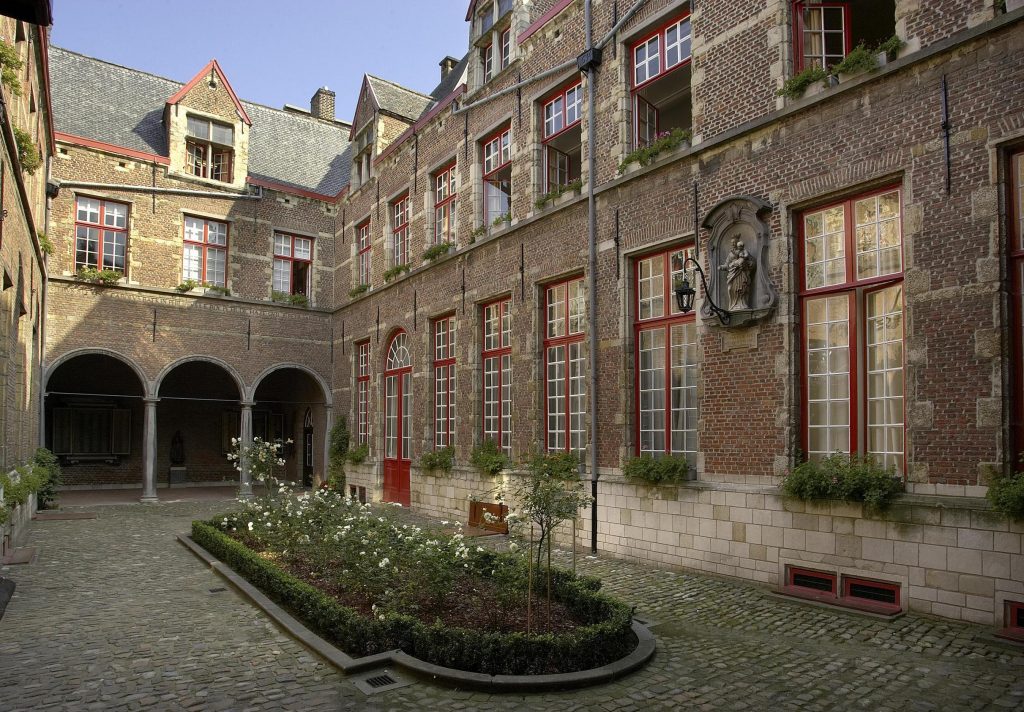About Daniël Christiaens
Daniël Christiaens received his M.A. in art history at the Katholieke Universiteit Leuven in 1982. His thesis on 20th-century fashion, The relation between fashion and the visual arts during the Interbellum: with special attention given to Sonia Delaunay, was a first at that university and parts of it were published in various magazines and bulletins. He has also lectured on the topic, and currently advises students working on fashion history.
During the winter of 1983 he volunteered at the Middelheim Open Air Sculpture Garden. In 1984 he began working for the Belgian OCMW (Openbaar Centrum voor Maatschappelijk Welzijn / Centre Publique d’Aide Sociale / Public Center of Social Welfare), where he initially curated an exhibition on the history of medical instruments and technology in 1988. From 1988 to 2003 he was a staff member of ELZENVELD, a socio-cultural center and exhibition space (part of the Antwerp OCMW), where he co-curated various exhibitions on contemporary artists from Belgium and abroad.
Since 2000 Christiaens has focused on the Maagdenhuismuseum, an orphanage for girls founded in 1552/53, which was turned into a museum in 1930. The museum festively celebrated its 80th anniversary on 24 June 2010. A small documentary exhibition was on view until the end of July. Christiaens was officially appointed senior curator at the museum in 2006.

The Maagdenhuis courtyard
About Museum Maagdenhuis
The Maagdenhuis is one of Antwerp’s smallest museums and figures prominently in the Public Center of Social Welfare’s early history. It still operates within the margins of this institution. Located in one of the city’s precious historic landmarks, the Maagdenhuis Museum is currently implementing professional approaches, including digitization (approximately 3,000 entries), restoration, and improvement of the state of the art museum infrastructure and technology through the application of a Solar Gard solar and UV protective window film, LED lighting, security, etc.
Favorite work of art
It is not easy to select a favorite work from the museum’s collection, but the Portrait of Simon de Vos by Abraham de Vries (1590-ca. 1650) certainly stands out. De Vries was born in Rotterdam and initially was influenced by Thomas de Keyser and subsequently by Rembrandt and Frans Hals. He was first mentioned in the parish registry of his birthplace in 1617. Eleven years later he was in Antwerp. From 1630 to 1640 he was active in Amsterdam, except for brief sojourns in Paris in 1634-1635, and Antwerp, where he received the title of “full master” in 1634. A decade later, he was accepted as a master in the Guild of Saint Luke in The Hague, and also in Rotterdam in 1647. He died in 1650.
This painting, presumably produced in the last house occupied by Simon de Vos, was owned by the Knechtjeshuis in Antwerp, the orphanage for boys run by Poor Relief and, as such, the fraternal institution of the Maagdenhuis. Because of the inscription (*) applied to the painting in 1678 or 1679 (that is after the sitter’s death in 1676) it was long considered to be a self-portrait by Simon de Vos. While the painting was being restored in 1909 a monogram was discovered in the right corner: “FECIT AdV Anno 1635.”

Daniël Christiaens in front of Abraham de Vries, Portrait of Simon de Vos
Several documents support the reading of the monogram as that of Abraham de Vries. A preliminary study for this portrait is in the Musée des Beaux-Arts in Lyons, France. The panel is striking, thanks to its vigorous execution and restrained color scheme. Simon de Vos is portrayed as a cheerful, elegant man of the world. It is one of the most charming portraits in the collection and also expresses contemporary views of charity: art and history coincide here in a beautiful and touching manner!
(*)
SIMON DE VOS HEEFT NAER DE CONST
HEM SELFS HIER VYTGEBEELT
EN TOT DEN ARMEN SYNE IONST
AEN YEDER VOOR GESTELT
MITS DEN ARMEN ERFGENAEM MAECKT
IN DE HELFT VAN SYN GOET
K. WENSCH DAT DAER DOOR V HERT GERAECKT
GHY OOCK HET SELVE DOET
HY LEEFDEN ARMELYCK
OM MET SYN GOET TE MAECKEN RYCK
DE CAEMER DER ARMEN
BIDT GODT SYN SIEL WILT ONTFERMEN
OBIIT. 15. OCTOB. A° 1676
AETA 73
(Simon de Vos presents himself here in art. And introduces to the poor his goodwill to everyone. If he wills half of his property to the poor I wish that your heart is touched to do the same. He lived soberly in order to enrich the Poor Relief with his possessions. May God take pity on his soul. Died 15 October in the year 1676 at the age of 73)
In conclusion, it feels odd to feature as Curator in the spotlight page among colleagues from the British Museum, the Kunsthistorisches Museum and so forth! Eight people work at the Maagdenhuis Museum (including one academic), giving you some idea of our position with respect to the more than 2,000 personnel of the Openbaar Centrum voor Maatschappelijk Welzijn / Public Center for Social Welfare!
I would like to thank CODART for this privilege. It is a unique platform, affording an opportunity to give our collection wider, more international exposure. I hope to participate in the next congress in Enschede and would like to repeat my suggestion for a congress theme: “Smaller museums and how they function among the Big Boys.” Perhaps we can devise a “survival kit”…

The gate to the Maagdenhuis
